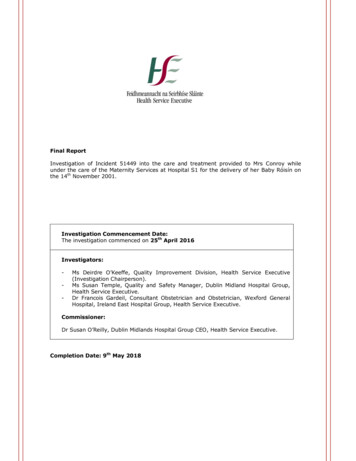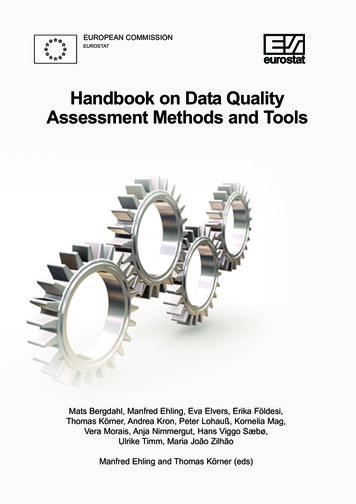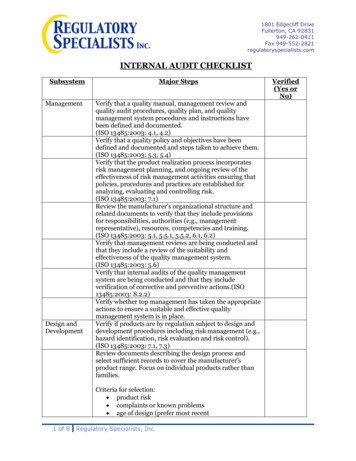
Transcription
Final ReportInvestigation of Incident 51449 into the care and treatment provided to Mrs Conroy whileunder the care of the Maternity Services at Hospital S1 for the delivery of her Baby Róisín onthe 14th November 2001.Investigation Commencement Date:The investigation commenced on 25th April 2016Investigators:-Ms Deirdre O’Keeffe, Quality Improvement Division, Health Service Executive(Investigation Chairperson).Ms Susan Temple, Quality and Safety Manager, Dublin Midland Hospital Group,Health Service Executive.Dr Francois Gardeil, Consultant Obstetrician and Obstetrician, Wexford GeneralHospital, Ireland East Hospital Group, Health Service Executive.Commissioner:Dr Susan O’Reilly, Dublin Midlands Hospital Group CEO, Health Service Executive.Completion Date: 9th May 2018
Final Report 51449Table of ContentsGlossary of Terms and Acronyms . 2Apology . 13Acknowledgement . 14Executive Summary. 15Methodology . 26Section 1: Background to this Investigation. 38Section 2: Chronology of Events . 44Section 3: Aftermath of Incident . 79Section 4: Key Causal Factors, Contributory Factors, Incidental Factors andLinked Recommendations . 90Action taken since the time of the events described in this report: . 106Incidental Findings . 123References: . 126APPENDIX A: 51449 TERMS OF REFERENCE . 134APPENDIX B: CONSULTANT OBSTETRICIAN AND GYNAECOLOGIST DISCLAIMER . 136APPENDIX C: REPORT DR. FRANCOIS GARDEIL, CONSULTANT OBSTETRICIAN AND GYNAECOLOGIST,WEXFORD GENERAL HOSPITAL, WEXFORD . 137APPENDIX D: REPORT DR. JOHN F. MURPHY, DEPT. OF NEONATOLOGY, THE NATIONAL MATERNITYHOSPITAL, DUBLIN . 141APPENDIX E: MIDWIFERY REPORT . 145APPENDIX F: CORRESPONDENCE FROM THE MEDICAL COUNCIL . 155APPENDIX G: NURSE/MIDWIFE SCOPE OF PRACTICE DECISION-MAKING FRAMEWORK 2000 (NMBI) . 159APPENDIX H: FRAMEWORK OF CONTRIBUTORY FACTORS . 160APPENDIX I: HIERARCHY OF HAZARD CONTROLS . 1641
Final Report 51449Glossary of Terms andADOMAssistant Director Of MidwiferyALPAn Alkaline phosphatase test measures the amount of the enzyme ALP in theblood. ALP is made mostly in the liver and in bone with some made in theintestines and kidneys. It also is made by the placenta of a pregnant woman.AFIAmniotic Fluid IndexAmnisure ROM testThe Amnisure ROM test is approved for the diagnosis of rupture ofmembranes (ROM).(Reference: 4/)AnoxicAnoxic - relating to or marked by a severe deficiency of oxygen in tissues ororgans (Reference: Antepartum - occurring or existing before birth; "the prenatal period";"antenatal care"(Reference: diesAntibody tests are done to find certain antibodies that attack red blood cells.Antibodies are proteins made by the immune system. Normally, antibodiesbind to foreign substances, such as bacteria and viruses, and cause them tobe destroyed.(Reference: Apgar scoreAn objective score of the condition of a baby after birth. This score isdetermined by scoring the heart rate, respiratory effort, muscle tone, skincolour, and response to a catheter in the nostril. Each of these objective signsreceives 0, 1, or 2 points. An Apgar score of 10 means an infant is in the bestpossible condition. The Apgar score is done routinely 60 seconds after thebirth of the infant. A child with a score of 0 to 3 needs immediateresuscitation. The Apgar score is often repeated 5 minutes after birth, and inthe event of a difficult resuscitation, the Apgar score may be done again at10, 15, and 20 pt/main/art.asp?articlekey 2303)Apgar Score: an index used to evaluate the condition of a new-born infantbased on a rating of 0, 1, or 2 for each of the five characteristics of colour,heart rate, response to stimulation of the sole of the foot, muscle tone, andrespiration with 10 being a perfect score. ry/apgar%20score)APTTPartial Thromboplastin Time is used when someone has unexplained bleedingor clotting. Along with the PT test (which evaluates the extrinsic and commonpathways of the coagulation cascade), the aPTT is often used as a startingplace when investigating the cause of a bleed or thrombotic (blood clot)episode. It is often used with recurrent miscarriages which may be associatedwith anticardiolipin or antiphospholipid antibodies. The aPTT and PT tests arealso sometimes used as pre-surgical screens for bleeding tendencies,although numerous studies have shown that they are not useful for g.uk/understanding/analytes/aptt/tab/test).2
Final Report 51449Artificial Ruptureof Membranes(ARM)An artificial rupture of the fetal membranes is usually performed to tomy)Baby Cooling /BrainHypothermiaBrain Hypothermia, induced by cooling a baby to around 33 C for three daysafter birth, is a treatment for hypoxic ischemic encephalopathy. It hasrecently been proven to be the only medical intervention which reduces braindamage, and improves an infant's chance of survival and reduced disability.Hypothermic neural rescue therapy is an evidence-based clinical treatmentwhich increases a severely injured full term infant's chance of survivingwithout brain damage detectable at 18 months by about 50%, an effect whichseems to be sustained into later childhood.(references: Edwards, AD; Brocklehurst, P; Gunn, AJ; Halliday, H; Juszczak,E; Levene, M; Strohm, B; Thoresen, M; Whitelaw, A; Azzopardi, D. (2010)."Neurological outcomes at 18 months of age after moderate hypothermia forperinatal hypoxic ischaemic encephalopathy: synthesis and meta-analysis oftrial data". BMJ (Clinical research ed.) 340: c363.Shankaran, S; Pappas, A; McDonald, SA; Vohr, SR; Hintz, SR; Yolton, K;Gustafson, KE; Leach, TM; Green, C et al. (2012). "Childhood outcomes afterhypothermia for neonatal encephalopathy". New England Journal of Medicine366 (22): 2085–92.Guillet, Róisín; Edwards, AD; Thoresen, M; CoolCap Trial Group (2011)."Seven- to eight-year follow-up of the CoolCap trial of head cooling forneonatal encephalopathy.". Pediatr Res 71 (2): 205–9.Rutherford, M; Ramenghi, LA; Edwards, AD; Brocklehurst, P; Halliday, H;Levene, M; Strohm, B; Thoresen, M et al. (2010). "Assessment of brain tissueinjury after moderate hypothermia in neonates with hypoxic-ischaemicencephalopathy: a nested substudy of a randomised controlled trial". Lancetneurology 9 (1): 39–45.Robertson, NJ; Nakakeeto, M; Hagmann, C; Cowan, FM; Acolet, D; Iwata, O;Allen, E; Elbourne, D et al. (2008). "Therapeutic hypothermia for birthasphyxia in low-resource settings: a pilot randomised controlled trial". Lancet372 (9641): 801–3.Baseline FHRVariabilityBaseline FHR variability is based on visual assessment and excludessinusoidal patterns. Variability is defined as fluctuations in the FHR baseline of2 cycles per minute or greater, with irregular amplitude and inconstantfrequency. These fluctuations are visually quantitated as the amplitude of thepeak to trough in beats per minute. By visual assessment, acceleration isdefined as an apparent abrupt increase in FHR above baseline, with the timefrom the onset of the acceleration to the acme of less than 30 seconds.Late deceleration is defined as an apparent gradual decrease and return tobaseline FHR in association with a uterine contraction, with the time fromonset of the deceleration to its nadir as 30 seconds or longer. Earlydeceleration is defined as an apparent gradual decrease and return to thebaseline FHR in association with a uterine contraction, with the time fromonset of the deceleration to its nadir as 30 seconds or longer.Variable deceleration is defined as an apparent abrupt decrease in FHR belowthe baseline, with the time from the onset of the deceleration to the nadir ofthe deceleration as less than 30 seconds. The decrease is measured from themost recently determined portion of the baseline. Variable decelerations mayor may not be associated with uterine contractions. The decrease frombaseline is 15 beats per minute or higher and lasts less than 2 minutes fromonset to return to baseline.3
Final Report 51449When variable decelerations occur in conjunction with uterine contractions,their onset, depth, and duration may vary with each successive uterinecontraction (Reference: Robinson B. (2008) A Review of NICHD StandardizedNomenclature for Cardiotocograph: The Importance of Speaking a CommonLanguage When Describing Electronic Fetal Monitoring. Rev Obstet Gynecol,2008 Spring; 1(2): 56-60(Available om/premature labor 5172/).Baseline FetalHeart Rate (FHR)Baseline fetal heart rate is the average fetal heart rate (FHR) rounded toincrements of 5 beats per minute during a 10-minute segment, excludingperiodic or episodic changes, periods of marked variability, or baselinesegments that differ by more than 25 beats per minute. In any given 10minute window, the minimum baseline duration must be at least 2 minutes,or else the baseline is considered indeterminate.In cases where the baseline is indeterminate, the previous 10-minute windowshould be reviewed and utilized in order to determine the baseline. A normalFHR baseline rate ranges from 110 to 160 beats per minute. If the baselineFHR is less than 110 beats per minute, it is termed bradycardia. If thebaseline FHR is more than 160 beats per minute, it is termed tachycardia.BHCGBeta Human Chorionic Gonadotrophin ( Pregnancy Hormone)BPBlood PressureBPSBiophysical Profile ScoreBradycardiaBradycardia is a slow heart rate usually defined as less than 60 beats perminute .asp?articlekey 2515)C&SCulture and SensitivityCaesarean SectionThere are two types of Caesarean Sections: the classical Caesarean Section,and the Lower Segment Caesarean Section. The classical section involves amidline longitudinal incision which allows a larger space to deliver the baby.The Lower Segment Caesarean Section, more commonly used today, involvesa smaller transverse cut which results in less blood loss and is easier to itationCardiopulmonary resuscitation involves physical interventions to createartificial circulation through rhythmic pressing on the patient's chest tomanually pump blood through the heart, called chest compressions, andusually also involves the rescuer exhaling into the patient (or using a deviceto simulate this i.e. an ambu bag and oxygen mask) to ventilate the lungsand pass oxygen in to the blood, called artificial respiration.CardiotocographyIn medicine (obstetrics), cardiotocography (CTG) is a technical means ofrecording (-graphy) the fetal heartbeat (cardio-) and the uterine contractions(-toco-) during pregnancy, typically in the third trimester. The machine usedto perform the monitoring is called a cardiotocograph, more commonly knownas an electronic fetal monitor (EFM).CephalicPresentationA cephalic presentation is a situation at childbirth where the foetus is in alongitudinal lie and the head enters the pelvis first; the most common form is4
Final Report 51449the vertex presentation where the occiput (back part of the head or skull) isthe leading part (Reference: Hellman LM, Pritchard JA. Williams Obstetrics,14th edition, Appleton-Century-Crofts (1971) Library of Congress CatalogueCard Number 73-133179. p. 322–2)CervixNeck of the WombCISThe Clinical Indemnity Scheme (CIS) was established in 2002, in order torationalise pre-existing medical indemnity arrangements by transferring tothe State, via the Health Service Executive (HSE), hospitals and other healthagencies, responsibility for managing clinical negligence claims and associatedrisks. nityScheme/introduction.html ).State Claims Agency (2009). The State Claims Agency Clinical ationReqs.pdfCMMClinical Midwife ManagerCommissionerThe commissioner of an investigation differs across the health system, but itis typically the senior accountable officer in a service, directorate or caregroup that commissions an investigation of a clinical or non-clinical incident.Cord blood PhA low pH (less than 7.04 to 7.10) means there are higher levels of acids inthe baby's blood. This might occur when the baby does not get enoughoxygen during labor(Reference: 3403.htm)CRPC-Reactive Protein, a measure of inflammationCTGCTG is a technical means of recording the fetal heartbeat and the uterinecontractions during pregnancy, typically in the third trimester. (Reference:Macones GA, Hankins GD, Spong CY, et al. The 2008 National Institute ofChild Health and Human Development workshop report on electronic fetalmonitoring: update on definitions, interpretation, and research guidelinesObstet Gynecol (2008) 112:661-666)A ‘Normal’ CTG is indicated when all four features (fetal heart rate, baselinevariability, acceleration and deceleration of the fetal heart rate and frequencyand strength of contractions as recorded by the attending healthcareprofessional) fall within the reassuring category i.e. they fall within thenormal ranges as outlined on page 16 of this report. A ‘Suspicious’ CTG iswhen one feature falls within the non-reassuring category and the remainderare reassuring. A ‘Pathological’ CTG is when two or more features fall withinthe non-reassuring category or one or more features fall within the abnormalcategory.CxCervixDCDischargeE. coliE. coli (Escherichia coli) is one of several types of Gram negative bacillibacteria that normally inhabit the intestine of humans. Some strains of E. coliare capable of causing disease under certain conditions.EDEmergency Department5
Final Report 51449EDDEstimated Date of t relates to the softening and shortening of the cervical canal fromabout 3cm long to less than 0.5cm long. (Reference: National CollaboratingCentre for Women’s and Children’s Health 2008 Clinical Guideline; Inductionof Labour RCOG Press London)EFWEstimated Fetal WeightElectronic FetalMonitor (EFM)In medicine (obstetrics), cardiotocography (CTG) is a technical means ofrecording (-graphy) the fetal heartbeat (cardio-) and the uterine contractions(-toco-) during pregnancy, typically in the third trimester. The machine usedto perform the monitoring is called a cardiotocograph, more commonly knownas an electronic fetal monitor (EFM)EndotrachealIntubationEndotracheal intubation is the insertion of a tube into the trachea forpurposes of anesthesia, airway maintenance, aspiration of secretions, lungventilation, or prevention of entrance of foreign material into the airway; thetube goes through the nose or mouth(Reference : tubation)EntonoxEntonox is used as an analgesia and can be self-administered using a demandvalve which is popular in obstetric practice (Reference: British NationalFormulary 2009)Early Pregnancy Assessment UnitEPAUEpiduralAnalgesiaEpidural analgesia is a central nerve blockade technique, which involves theinjection of a local anaesthetic, with or without an opioid into the lower regionof the spine close to the nerves that transmit painful stimuli from thecontracting uterus and birth Spectrum Beta-Lactamases ESBL-producing bacteria are bacteriathat produce enzymes that may break down commonly used antibiotics.Fetal ScalpElectrodeAn electrode that is attached to the baby’s scalp and connected to the CTGmachine so that a trace of the fetal heart can be recorded electronicallyFHHRFetal Heart Heard and RegularFHHFetal Heart HeardFHRFetal Heart RateFetal BiometricParametersFetal biometric parameters are various antenatal ultrasound measurementsthat are used to indirectly assess the growth and wellbeing of the foetus andin assessing dates - gestational age(Reference: rameters)FetalBradychardiaAn abnormally slow fetal heart rate, usually below 100 beats/min. ReferenceMosby's Medical Dictionary, 8th edition. 2009, Elsevier.Full Blood Count(FBC)Full Blood Count (FBC) is used as a broad screening test to check for suchdisorders as anaemia, infection, and many other diseases. It is a panel of6
Final Report 51449teststhatexaminesdifferent partsof k/understanding/analytes/fbc/tab/test).Fundal HeightFundal height is the height of the fundus of the uterus, measured incentimetres from the top of the symphysis pubis to the highest point in themidline at the top of the uterus. Fundal height is measured at each prenatalvisit with large blunt callipers or with a tape measure. From the twentieth tothe thirty-second week of pregnancy the height in centimetres is equal to thegestation in weeks nary.com/fundal height).GovernanceThe system by which organisations direct and control their functions andrelate to their stakeholders in order to manage their business, achieve theirmissions and objectives and meet the necessary standards of accountability,integrity and propriety (HSE, 2006).GPGeneral practitionerGram negativebacilliGram negative bacilli are a type of bacteria. The name is derived from a typeof staining called Gram staining where these particular bacteria do not retainthe stain. This is characteristic of bacteria having a cell wall surface morecomplex in chemical composition than the gram-positive bacteria.GTTGlucose Tolerance TestHaemoglobin (Hb)A conjugated protein, consisting of haem & the protein globin that gives redblood cells their characteristic colour. It combines reversibly with oxygen andis thus very important in the transportation of oxygen to tissues(Reference: http://www.thefreedictionary.com/haemoglobin).Low levels of haemoglobin in pregnancy can indicate anaemia(Referen
as an electronic fetal monitor (EFM). Cephalic Presentation A cephalic presentation is a situation at childbirth










